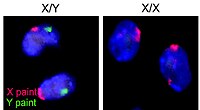
Photo from wikipedia
STUDY QUESTION What are the in vivo and in vitro actions of kisspeptin-54 on the expression of genes involved in ovarian reproductive function, steroidogenesis and ovarian hyperstimulation syndrome (OHSS) in… Click to show full abstract
STUDY QUESTION What are the in vivo and in vitro actions of kisspeptin-54 on the expression of genes involved in ovarian reproductive function, steroidogenesis and ovarian hyperstimulation syndrome (OHSS) in granulosa lutein (GL) cells when compared with traditional triggers of oocyte maturation? SUMMARY ANSWER The use of kisspeptin-54 as an oocyte maturation trigger augmented expression of genes involved in ovarian steroidogenesis in human GL cells including, FSH receptor (FSHR), LH/hCG receptor (LHCGR), steroid acute regulatory protein (STAR), aromatase, estrogen receptors alpha and beta (ESR1, ESR2), 3-beta-hydroxysteroid dehydrogenase type 2 (3BHSD2) and inhibin A (INHBA), when compared to traditional maturation triggers, but did not alter markers of OHSS. WHAT IS KNOWN ALREADY hCG is the most widely used trigger of oocyte maturation, but is associated with an increased risk of OHSS. The use of GnRH agonists to trigger oocyte maturation is a safer alternative to hCG. More recently, kisspeptin-54 has emerged as a novel therapeutic option that safely triggers oocyte maturation even in women at high risk of OHSS. Kisspeptin indirectly stimulates gonadotropin secretion by acting on hypothalamic GnRH neurons. Kisspeptin and its receptor are also expressed in the human ovary, but there is limited data on the direct action of kisspeptin on the ovary. STUDY DESIGN SIZE, DURATION Forty-eight women undergoing IVF treatment for infertility consented to kisspeptin-54 triggering and/or granulosa cell collection and were included in the study. Twelve women received hCG, 12 received GnRH agonist and 24 received kisspeptin-54 to trigger oocyte maturation. In the kisspeptin-54 group, 12 received one injection of kisseptin-54 (9.6 nmol/kg) and 12 received two injections of kisspeptin-54 at a 10 h interval (9.6 nmol/kg × 2). PARTICIPANTS/MATERIALS, SETTING, METHODS Follicular fluid was aspirated and pooled from follicles during the retrieval of oocytes for IVF/ICSI. GL cells were isolated and either RNA extracted immediately or cultured in vitro ± kisspeptin or hCG. MAIN RESULTS AND THE ROLE OF CHANCE GL cells from women who had received kisspeptin-54 had a 14-fold and 8-fold higher gene expression of FSHR and a 2-fold (ns) and 2.5-fold (P < 0.05) higher expression of LHCGR than GL cells from women who had received hCG or GnRH agonist, respectively. CYP19A1 expression was 3.6-fold (P < 0.05) and 4.5-fold (P < 0.05) higher, STAR expression was 3.4-fold (P < 0.01) and 1.8-fold (P < 0.05) higher, HSD3B2 expression was 7.5- (P < 0.01) and 2.5-fold higher (P < 0.05), INHBA was 2.5-fold (P < 0.01) and 2.5-fold (P < 0.01) higher in GL cells from women who had received kisspeptin-54 than hCG or GnRHa, respectively. ESR1 (P < 0.05) and ESR2 (P < 0.05) both showed 3-fold higher expression in cells from kisspeptin treated than GnRHa treated women. Markers of vascular permeability and oocyte growth factors were unchanged (VEGFA, SERPINF1, CDH5, amphiregulin, epiregulin). Gene expression of kisspeptin receptor was unchanged. Whereas treating GL cells in vitro with hCG induced steroidogenic gene expression, kisspeptin-54 had no significant direct effects on either OHSS genes or steroidogenic genes. LIMITATIONS REASONS FOR CAUTION Most women in the study had PCOS, which may limit applicability to other patient groups. For the analysis of the in vitro effects of kisspeptin-54, it is important to note that GL cells had already been exposed in vivo to an alternate maturation trigger. WIDER IMPLICATIONS OF THE FINDINGS The profile of serum gonadotropins seen with kisspeptin administration compared to other triggers more closely resemble that of the natural cycle as compared with hCG. Thus, kisspeptin could potentially permit an ovarian environment augmented for steroidogenesis, in particular progesterone synthesis, which is required for embryo implantation. STUDY FUNDING/COMPETING INTEREST(S) Dr Owens is supported by an Imperial College London PhD Scholarship. Dr Abbara is supported by an National Institute of Health Research Academic Clinical Lectureship. The authors do not have any conflict of interest to declare. TRIAL REGISTRATION NUMBER ClinicalTrials.gov NCT01667406.
Journal Title: Human Reproduction
Year Published: 2018
Link to full text (if available)
Share on Social Media: Sign Up to like & get
recommendations!